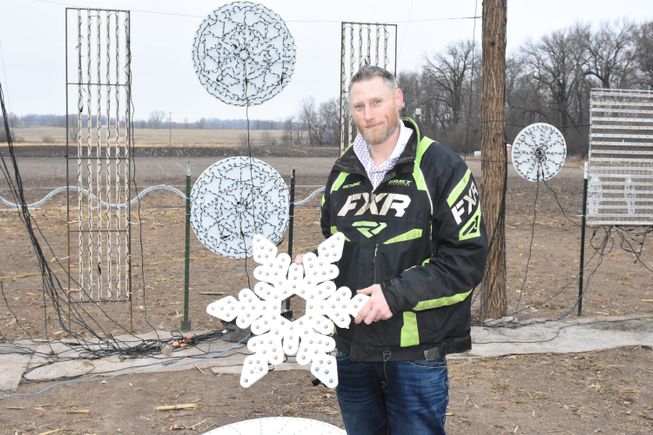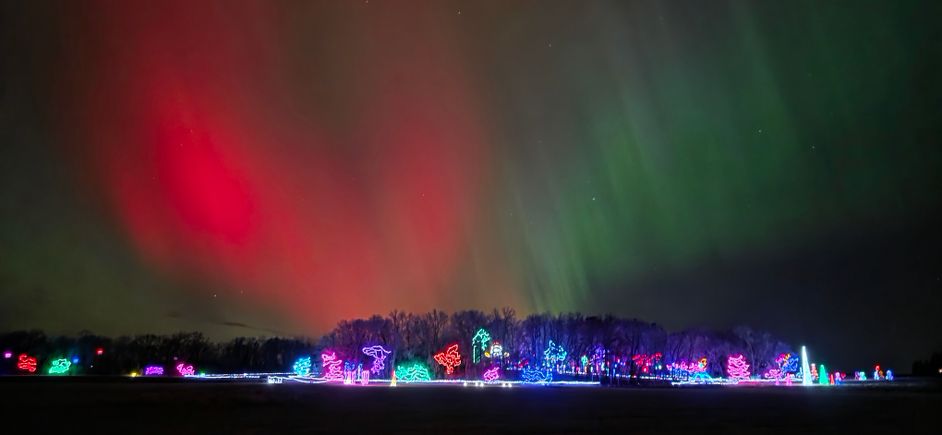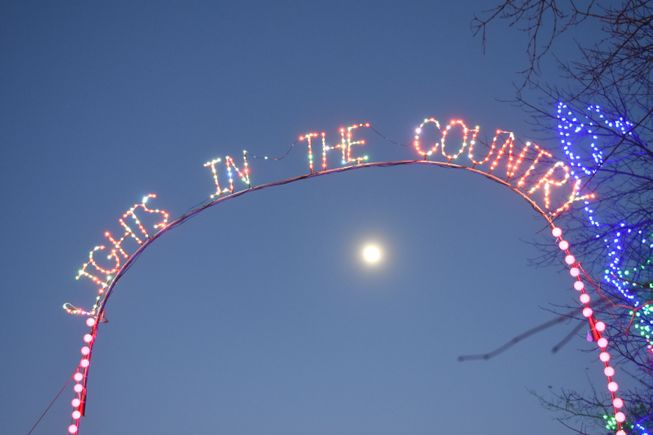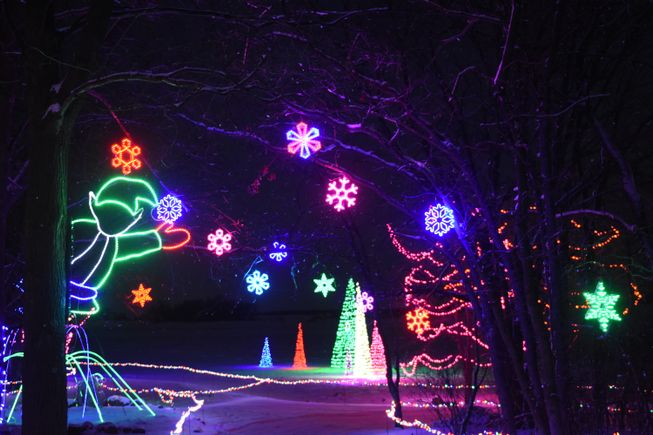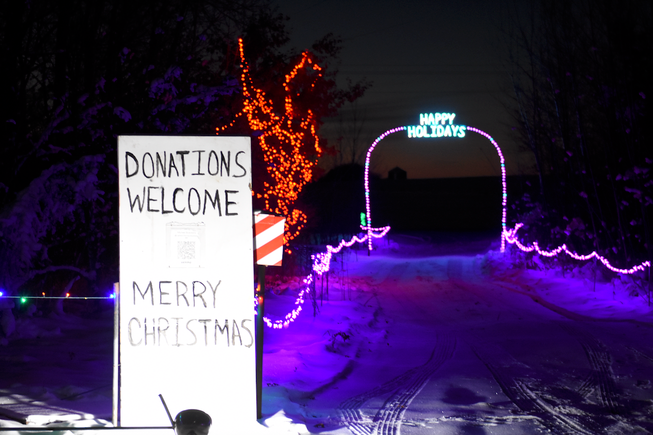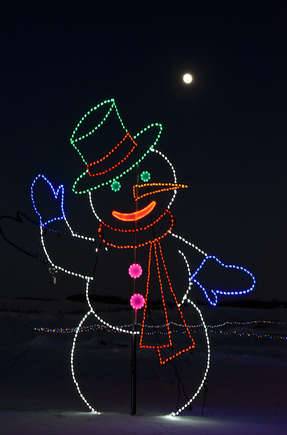Holiday display for everyone
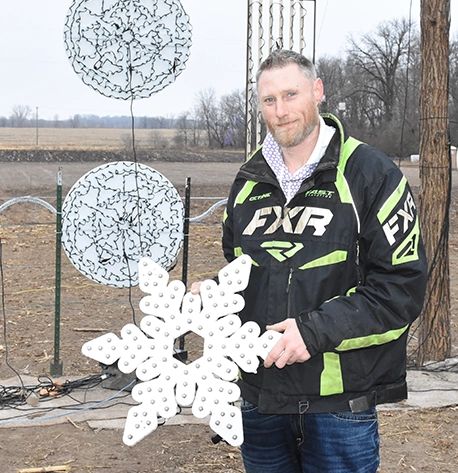
Bueckers sets up, runs Lights in the Country for nearly a decade
By Ben Sonnek
STAFF WRITER
ALBANY — When Mike Bueckers first put up a Christmas lights display on his land, it was for his grandmother, Armella Bueckers. Nine years later, he now sets up the show for everyone — as well as for his grandmother and mother, Laurie Hull, for he knows they have the best seats for it.
“A lot of people see it as just some amazing Christmas display, but to me and others, it’s a much more personal connection,” Mike said.
“The bigger trees down there, as you come up to the roundabout, those are (dedicated to) family members who have passed; my grandma (and) my mom have their own trees, (as well as) an aunt and a couple of cousins, and there is a section for cancer ribbons. … Enjoy it, but be respectful of others.”
During the holiday season, Armella enjoyed traveling to see Christmas lights displays, especially ones in the Twin Cities. That grew more difficult to do as she got older, though, so in 2016, Mike set up some lights on his property at 36252 245th Avenue, Albany. Because Armella lived in Albany, she could come and see them easier.
“I decided to give her something a little closer to home,” Mike said. “I tried to get them (the lights) all up in the trees as high as possible, hoping she could see them from her house in town. … She didn’t get to see them from there, but we had family Christmas in town, and my aunts and uncles brought her out. … She really loved it.”
Armella passed away in November 2017.
“Before she passed, I told her I was going to keep the display going so she could see from above and enjoy it,” Mike said. “Then, I got to thinking about the smile it brought her and the sparkle I saw in her eyes, that I wanted to continue to bring that to others who were in her similar situation, who couldn’t get out and do much.”
After setting up his lights in 2017, Mike opened it to the public as Lights in the Country, especially hoping area nursing homes would be able to come out for the display. He had a fair number of people come through, including those from a local nursing home. From there, Mike kept improving his displays, and more people kept coming.
Lights in the Country’s initial display covered Mike’s driveway and the roundabout in front of his house. Later, though, Mike heard about displays incorporating music light shows.
“I thought, ‘There’s no way I’ll ever be that big,’” he said. “Boy, was I wrong. Next thing you know, I’m running them (lights) along my woods’ edge and through my field, and I got the light show in the field, and it’s gotten bigger ever since.”
Mike tries to keep his displays more traditional, nothing too bright or flashy, not only to avoid seizures but also to give visitors a more laid-back experience. The light show in the field is synchronized with the 96.1 FM radio station.
By Mike’s estimates, he has enough lights set up around his property to make it to Albany twice; it takes a whole mile of lights just to line the driveway, plus several more miles for the trees. When Mike started with cheap bulbs, it would take him hours to go through and replace bulb after bulb, and he had to bring them inside when it got too cold. When Mike’s mother became sick, he upgraded the display to more expensive, commercial-grade LEDs, which cut back on hassle and energy bills. This allowed him to care for and spend time with his mother before she passed away in 2023.
“I’d say I’m up to 140,000 to 150,000 individual lights all over the place,” Mike said. “I’ve thrown away thousands of dollars in lights being garbage.”
The light show also has fireworks as part of its epic show nights. Additionally, all the decorations — from the roof-mounted Santa and Grinch frames to the light show itself — are custom made by Mike.
Mike begins setting up lights in September, starting a little sooner every year so he has time to put up everything. He makes the parking lot for the light show once the corn is out of his field, which is usually around the end of October. Mike takes the entire month of November off work so he can finish the display, which is ready for visitors by Thanksgiving, weather permitting.
Lights in the Country runs from 5-10 p.m. Monday through Thursday, and Friday through Sunday, it runs 5-11 p.m.; Mike encourages people to follow the attraction on Facebook so they can get updates such as weather-related closures. The season ends around the first or second Sunday of January, but with the snow, it usually is not until the early spring that Mike can start taking things down.
One of the major additions to this year’s display is not related to lights; it is a portable restroom.
“I figured it’s time to make it more convenient for people when they come out here,” Mike said. “If you listen to every song before you leave, you’re going to sit here for close to two hours. You’ll get a bunch of people who drive through twice.”
Lights in the Country brings in visitors from all over — Paynesville, Willmar, Brainerd, Foley and even out of state.
“There was one family I was talking to, and they were from New Jersey,” Mike said. “They come out here every year … to see their family, and they make sure to come see the display (as well).”
When Mike is home, he will sometimes go out dressed as the Grinch, taking pictures for people and pretending to steal lights. While out there, he gets to see his favorite part of the display: families enjoying themselves.
“It’s a great feeling to know I can bring that joy to others that I brought to my grandma when I first started,” Mike said. “I’d like to keep it going. I run all this off of freewill donations; it might be on my property, I might put it all up, but I don’t look at it as my display. It’s everybody’s display.”
By Ben Sonnek
STAFF WRITER
ALBANY — When Mike Bueckers first put up a Christmas lights display on his land, it was for his grandmother, Armella Bueckers. Nine years later, he now sets up the show for everyone — as well as for his grandmother and mother, Laurie Hull, for he knows they have the best seats for it.
“A lot of people see it as just some amazing Christmas display, but to me and others, it’s a much more personal connection,” Mike said.
“The bigger trees down there, as you come up to the roundabout, those are (dedicated to) family members who have passed; my grandma (and) my mom have their own trees, (as well as) an aunt and a couple of cousins, and there is a section for cancer ribbons. … Enjoy it, but be respectful of others.”
During the holiday season, Armella enjoyed traveling to see Christmas lights displays, especially ones in the Twin Cities. That grew more difficult to do as she got older, though, so in 2016, Mike set up some lights on his property at 36252 245th Avenue, Albany. Because Armella lived in Albany, she could come and see them easier.
“I decided to give her something a little closer to home,” Mike said. “I tried to get them (the lights) all up in the trees as high as possible, hoping she could see them from her house in town. … She didn’t get to see them from there, but we had family Christmas in town, and my aunts and uncles brought her out. … She really loved it.”
Armella passed away in November 2017.
“Before she passed, I told her I was going to keep the display going so she could see from above and enjoy it,” Mike said. “Then, I got to thinking about the smile it brought her and the sparkle I saw in her eyes, that I wanted to continue to bring that to others who were in her similar situation, who couldn’t get out and do much.”
After setting up his lights in 2017, Mike opened it to the public as Lights in the Country, especially hoping area nursing homes would be able to come out for the display. He had a fair number of people come through, including those from a local nursing home. From there, Mike kept improving his displays, and more people kept coming.
Lights in the Country’s initial display covered Mike’s driveway and the roundabout in front of his house. Later, though, Mike heard about displays incorporating music light shows.
“I thought, ‘There’s no way I’ll ever be that big,’” he said. “Boy, was I wrong. Next thing you know, I’m running them (lights) along my woods’ edge and through my field, and I got the light show in the field, and it’s gotten bigger ever since.”
Mike tries to keep his displays more traditional, nothing too bright or flashy, not only to avoid seizures but also to give visitors a more laid-back experience. The light show in the field is synchronized with the 96.1 FM radio station.
By Mike’s estimates, he has enough lights set up around his property to make it to Albany twice; it takes a whole mile of lights just to line the driveway, plus several more miles for the trees. When Mike started with cheap bulbs, it would take him hours to go through and replace bulb after bulb, and he had to bring them inside when it got too cold. When Mike’s mother became sick, he upgraded the display to more expensive, commercial-grade LEDs, which cut back on hassle and energy bills. This allowed him to care for and spend time with his mother before she passed away in 2023.
“I’d say I’m up to 140,000 to 150,000 individual lights all over the place,” Mike said. “I’ve thrown away thousands of dollars in lights being garbage.”
The light show also has fireworks as part of its epic show nights. Additionally, all the decorations — from the roof-mounted Santa and Grinch frames to the light show itself — are custom made by Mike.
Mike begins setting up lights in September, starting a little sooner every year so he has time to put up everything. He makes the parking lot for the light show once the corn is out of his field, which is usually around the end of October. Mike takes the entire month of November off work so he can finish the display, which is ready for visitors by Thanksgiving, weather permitting.
Lights in the Country runs from 5-10 p.m. Monday through Thursday, and Friday through Sunday, it runs 5-11 p.m.; Mike encourages people to follow the attraction on Facebook so they can get updates such as weather-related closures. The season ends around the first or second Sunday of January, but with the snow, it usually is not until the early spring that Mike can start taking things down.
One of the major additions to this year’s display is not related to lights; it is a portable restroom.
“I figured it’s time to make it more convenient for people when they come out here,” Mike said. “If you listen to every song before you leave, you’re going to sit here for close to two hours. You’ll get a bunch of people who drive through twice.”
Lights in the Country brings in visitors from all over — Paynesville, Willmar, Brainerd, Foley and even out of state.
“There was one family I was talking to, and they were from New Jersey,” Mike said. “They come out here every year … to see their family, and they make sure to come see the display (as well).”
When Mike is home, he will sometimes go out dressed as the Grinch, taking pictures for people and pretending to steal lights. While out there, he gets to see his favorite part of the display: families enjoying themselves.
“It’s a great feeling to know I can bring that joy to others that I brought to my grandma when I first started,” Mike said. “I’d like to keep it going. I run all this off of freewill donations; it might be on my property, I might put it all up, but I don’t look at it as my display. It’s everybody’s display.”


